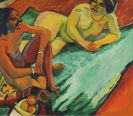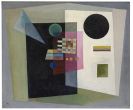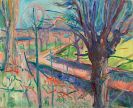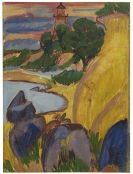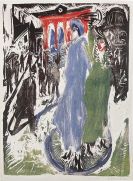
Franz Marc
München
1880 -
Verdun
1916
The German painter Franz Marc was born in Munich in 1880. Franz Marc begins his studies of philology and theology at the Munich University in 1899. He changes to the academy in 1900 and studies painting under Gabriel von Hackl and Wilhelm von Diez.
Franz Marc travels to Paris in 1903 for the first time. He sees works of French impressionists which impress him very much. But also works by Toulouse-Lautrec, Pierre Bonnard or Edouard Vuillard fascinate him, however, it is especially paintings by Vincent van Gogh that leave the deepest impression with him.
He does pictures of animals around 1903-04, that he more and more stylizes and simplifies. Franz Marc seeks a way to depict not just the animal's outer appearance, but their inner character the way he feels it.
He becomes a member of the "Neue Künstlervereinigung München" (Munich New Artists Association) in 1909. His first exhibition takes place in Brakl's "Moderner Kunsthandlung" (Brakl's Modern Arts Shop) in 1910, which calls the attention of August Macke and Bernhard Koehler who then visit Macke in Sindelsdorf in Upper Bavaria to where he had moved the same year. Koehler becomes Marc's patron, they sign a contract granting Koehler purchase options for his works, which makes Marc financially independent.
The hostile criticism of the Artist Association's second exhibition in 1910 makes Franz Marc write an enthusiastic review, hence he is accepted into the artists circle around Wassily Kandinsky. Having met Kandinsky stimulates Marc to deal with the symbolic powers of the colors more deeply, both discuss the effects and regularities thereof.
Franz Marc and Kandinsky leave the Artists Association in 1911 to protest against the refusal of a painting by Kandinsky for the third exhibition. Together they start the artists group "Der Blaue Reiter" (The Blue Rider). In 1911 the first exhibition takes places in the gallery Thannhauser. The second follows a year later in the gallery Goltz, almost exclusively with graphic works, but also with works of the expressionist "Brücke" (Bridge) artist Paul Klee as well as the Russian avant-garde artists Kasimir Malewitsch, Natalia Gontscharowa and Michail Larionow.
Also in 1912 Franz Marc and Kandinsky publish the almanac "Der Blaue Reiter" (The Blue Rider).
Franz Marc and August Macke travel to Paris again in 1912, a visit to Robert Delaunay in his studio leaves the artist quite impressed, triggering a change in style. Under the impression of the "Window" pictures by Delaunay, but also by works of the Italian Futurists, Marc begins to break up prismatic forms, slowly attaining complete abstraction, however, he on and off returns to the figurative animal symbol.
He volunteers to serve in World War I and is fatally injured by a grenade near Verdun on March 4, 1916. Among the things found on him was a sketchbook with preliminary studies for abstract paintings that he would never make.
Would you like to sell a work by Franz Marc?
Infos for seller


